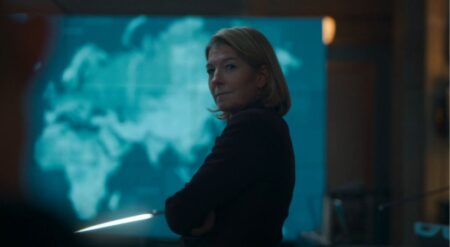
Young Justice: Outsiders, the third season of Young Justice, is back from its hiatus with dropped three new episodes on the DC Universe streaming service: “Influence,” “Leverage,” and “Illusion of Control.” Previously, the Justice League split after Batman (Bruce Greenwood) and a few other heroes, including members of Young Justice, left with him. As Dick Grayson (Jesse McCartney) and his small team investigate the disappearance of Earthling meta-humans, new enemies are revealed. Beast Boy was able to find a correlation between the goode googles, created by Goode World Studios which is run by Granny Goodness, and the meta-human trafficking ring. After Dick Grayson and his covert team were able to rescue a group of teenagers, including the princess of Tara, it is revealed that despite being rescued, Tara is working as a double agent for Slade and the trafficking efforts.
Now, the core members of the Justice League, Superman (Nolan North), Wonder Woman, Hawkman, Hawkwoman, and Guy Gardner Green Lantern, are in space investigating an attack on the ninth metal stockpiles in Thanagar, meaning Apokolips has another rare metal in their possession. Overall, the League is stuck handling off-world matters and trying to restore their reputation on Earth as Lex Luther run the UN.
One of the main issues with previous Young Justice seasons and Young Justice: Outsiders is it’s difficult handling such a large ensemble cast. The immediate opening with the Justice League, after such a long hiatus, is disorienting. Viewers haven’t really seen this Guy Gardner in action and now he is playing a serious role in hunting down the intergalactic threats to the team.
Similarly, when we join the team again at Young Justice, the focus is on new characters but it is hard to care about them since they are mostly thrown into the story with little to no introduction or emotional connection. Their stories are the main plot of these episodes and this season but I still can’t help but care more about the heroes we already know, like Dick Grayson, Conner Kent (Nolan North), and Artemis Crock (Stephanie Lemelin).
Halo/Violet (Zehra Fazal) comes out as non-binary but her entire character is questionable. While Halo is a Middle-Eastern girl, physically, the spirit of a Mother Box has taken over the body. And by doing this, making nothing about Halo Middle-Eastern, outside of her appearance. The body originally belonged to Gabrielle Daou, from Qurac, the western neighbor of Bialya, a fictional country that is coded as Middle-Eastern. But Gabrielle is effectively dead now as the Mother Box lives in her body. This questionable portrayal of representation extends to their identify as non-binary. While having a non-binary character represented is amazing, it is explained that they feel that way because they are created from a Mother Box, not because that’s who they are. The moment could have been handled better, since Halo is one of the few new characters the show has taken time to develop and yet she still is problematic.
In regards to more brand new characters, episode 15 “Leverage,” shows us inside the Taos youth meta-center. There is a group of young teens learns to control their powers and try to assimilate back into society. The scene also reintroduces us to the runaways from season two. Unfortunately, though, season two did not adequately introduce those characters so a lot of the moments are touching but don’t have any real impact. Episode 16, “Illusion of Control,” is completely dedicated to the former runaways, particularly Eduardo ‘Ed’ Dorado Jr. (Freddy Rodríguez) who now works as a counselor
Between the meta-teen trafficking, Apokolips’ relationship with the rest of the universe, Lex Luther running the UN and the Justice League’s split, his season has focused heavily on the politics of the show, which on paper is amazing. It resembles a lot of the Civil War comics from Marvel, however, the large cast makes it hard to truly see each side and the emotional weight. A lot of characters at this point aren’t even involved with the main schism that opened the season. Having such a long hiatus also does not help the show.
However, there are still a lot of strong points. The animation quality of these three episodes is much high than in other episodes of season three. Additionally, the voice acting is fantastic and features such a large and stellar cast. Also, Young Justice: Outsiders excels at keeping tensions high. Even when episodes aren’t action-heavy, the amount of espionage and undercover happenings keep the story interesting. It can, however, get convoluted when you add in so many characters.
Overall, the first three episodes are a good start to the end of this season. While not my favorite season of Young Justice, season three as a whole has been far from bad. I will warn viewers that episode 16 has some very concerning ableism that I felt triggered by as a disabled woman. I’m still hopeful future episodes will take time to develop each character, new and old, before introducing more. But either way, the idea of the team taking on Apokolips has me here for the long haul – unless the ableism continues.
Young Justice: Outsiders is streaming now on the HBO Max.
Young Justice: Outsiders Season 3, Episodes 14-16
-
Young Justice: Outsiders Season 3, Episodes 14-16 - 6/106/10
TL;DR
Overall, the first three episodes are a good start to the end of this season. While not my favorite season of Young Justice, season three as a whole has been far from bad. I will warn viewers that episode 16 has some very concerning ableism that I felt triggered by as a disabled woman.







